Articles
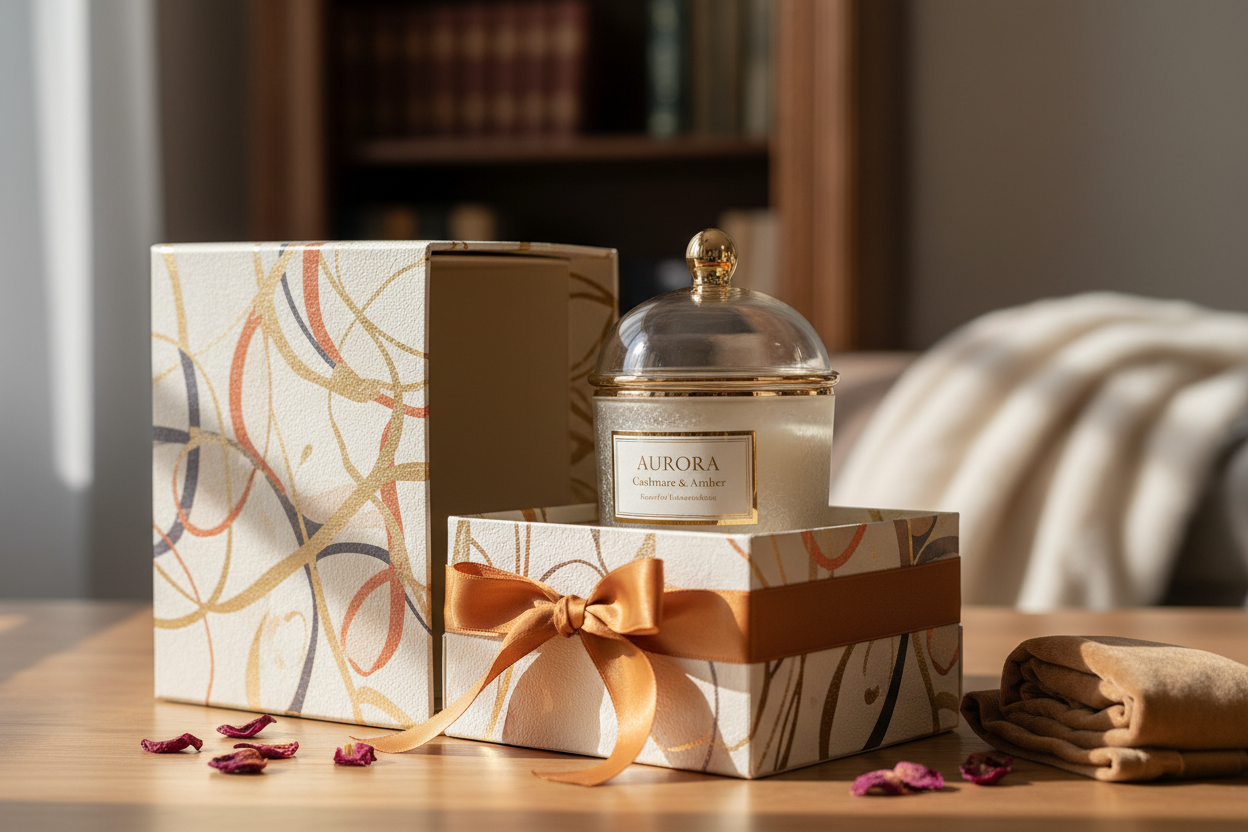
Article
Candle Gift Wrap Tips: How to Wrap a Candle as a Gift
A well-wrapped candle adds to the experience of giving it. Presentation matters, especially for handmade or fragrance-driven gifts. With the right approach, wrapping becomes part of what makes the candle feel thoughtful and complete.
Choose Materials That Work for Candle Wrapping
Start with a Sturdy Candle Gift Base
Jars, tins, and glass vessels need support. A snug box, tray, or insert prevents shifting and absorbs impact during handling. Too much space inside the packaging leads to unnecessary movement, especially during transport. A stable foundation also makes the outer wrap look neater.
Use Wrapping Paper That Supports Candle Shapes
Thin or glossy paper can tear easily under the weight of a candle. Thicker sheets with a bit of texture hold creases better and resist punctures. If there’s any wax residue on the container, use an inner layer, like unbleached tissue, to avoid oil spots bleeding through.
Add Cushioning Without Messing Up Your Candle Gift Wrap
Packing materials should secure the candle, not overwhelm it. Folded tissue, paper shred, or molded trays keep things tight without adding bulk. The candle should sit firmly with minimal room to shift, especially around the base and lid.
Creative Candle Gift Wrapping Ideas
Minimalist Wraps for Jar Candles
A jar wrapped in craft paper and tied with twine offers a clean look. This style leaves space for the scent label to show or allows a tag to carry that information. A wax seal or textured sticker adds detail without overdoing it.
Fabric Gift Wrapping Techniques for Candles
Cotton and linen squares can be folded and tied around the candle, adding softness and structure in one step. These wraps work especially well for smaller vessels or tins. No tape required, just a clean knot or fold keeps it together.
Gift Bags vs. Boxes for Wrapping a Candle as a Present
Bags are quick, but often lack structure. Boxes protect better and keep decorative touches in place. A rigid base also helps avoid tipping and makes it easier to stack or store wrapped candles during peak seasons.
Common Candle Wrapping Mistakes to Avoid
Don’t Skip Protection When Wrapping a Candle
A candle may feel sturdy, but it’s still a weighty, fragile product. Glass can crack, lids can dent, and even thick paper won’t help if there’s no internal support. Use padding and box inserts to reduce risk, especially for breakable containers.
Prevent Wax Smudges While You Gift Wrap
Even a small smear of wax or fragrance oil can stain wrapping paper. Wipe down jars before packaging and use a buffer layer between the candle and exterior wrap. Keeping the surface clean helps the entire gift feel more polished.
Keep Candle Labels Visible (When It Matters)
Scent names, burn instructions, and branding often sit front and center on the candle. If wrapping completely covers the label, include a hang tag or apply a label to the exterior packaging. That extra step avoids confusion, especially in gift sets.
Candle Gift Bundle Packaging Ideas
How to Arrange Multiple Candles in One Gift
Weight and balance matter when wrapping more than one candle. Place heavier jars at the base and use dividers or molded trays to separate each vessel. This keeps the bundle clean-looking and safe to handle.
Finishing Touches for Safe, Gift-Ready Candle Wrap
Ribbon, string, and tags work best when they don’t press directly against the candle. Avoid embellishments with scent or oils, especially if they’ll touch the wax or lid. Stick to dry, inert materials that won’t affect the fragrance or integrity of the candle.
Final Details That Elevate Candle Gift Presentation
Add a Note or Tag to Your Candle Gift Packaging
A small tag with a scent name, brand mark, or gift message adds a personal layer without crowding the wrap. For seasonal or custom candles, this also helps the recipient know what they’re getting before the lid comes off.
Store-Bought vs. DIY Candle Gift Wrap
There’s no need for elaborate designs. Crisp folds, well-cut paper, and a clean ribbon can make just as strong an impression. Whether made in-house or prepped for retail, the goal stays the same: clean, protective, and gift-ready without distraction.
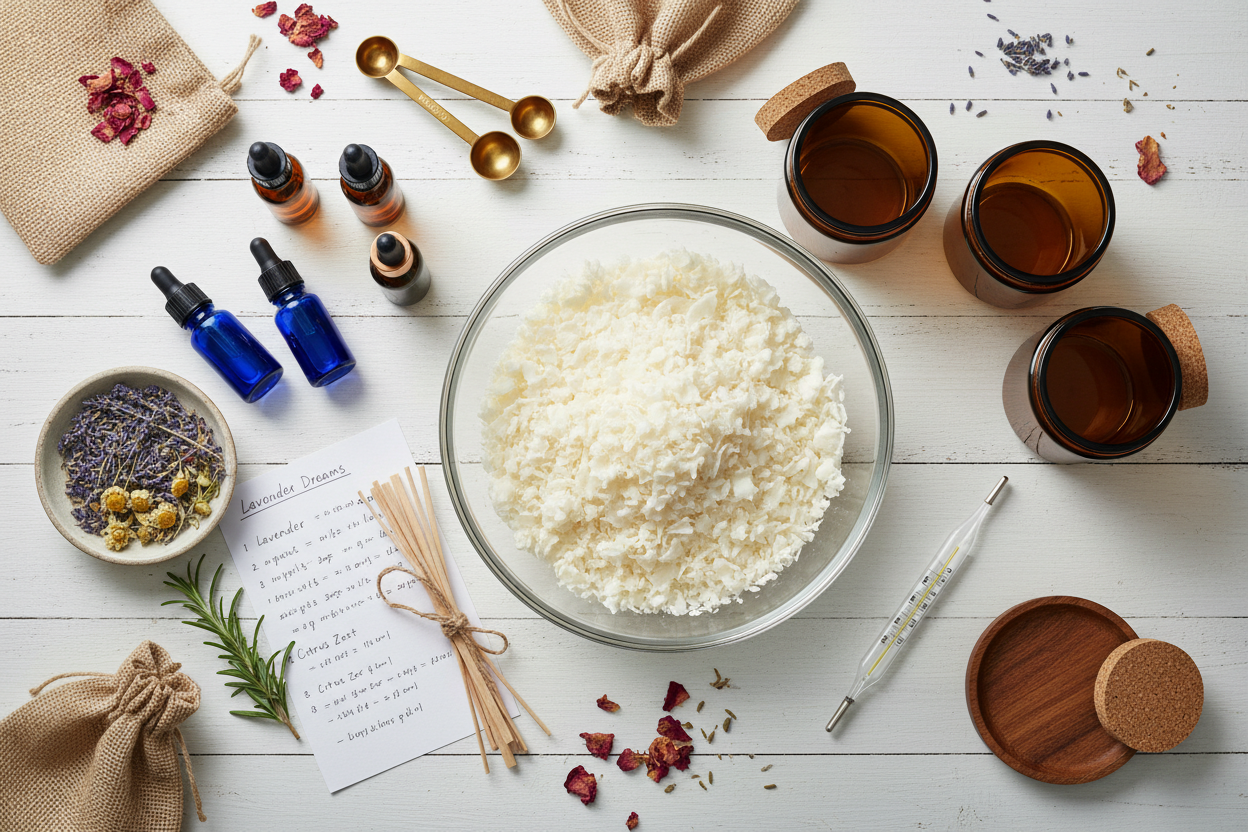
Article
Create Your Own DIY Candle Kit with Custom Recipes
Building a DIY candle kit puts you in full control of your process, materials, and final product. Instead of relying on pre-packed sets, you can tailor every part of the experience, wax type, wick size, fragrance blends, and containers, based on what works best for your space or your customers. It’s more than just crafting; it’s learning how to make candles perform the way they’re supposed to.
Why Build Your Own Candle Kit?
Store-bought kits usually include general-purpose components designed for basic use. That can be helpful in early experiments, but once you’ve poured a few candles, it becomes clear that results improve when the kit matches your preferences and conditions. Your space, fragrance choices, and container styles all affect burn quality. A homemade kit lets you address those variables right away.
Custom kits are also easier to replenish. You’re not locked into a fixed inventory. You can scale up or swap things out based on the seasons, your testing notes, or your scent goals.
What to Include in a Candle Making DIY Kit
The best kits are built around reliable, container-safe supplies. Start by focusing on the four core components: wax, wick, fragrance, and tools. Each of these plays a role in how the candle burns and smells over time.
Choosing the Right Wax
For most beginners, soy wax offers the smoothest learning curve. It holds fragrance well, cools with a creamy finish, and works in a variety of containers. Paraffin wax remains a top performer in scent throw and glass adhesion, though it may require more attention to wick sizing.
Beeswax burns longer and has natural color and scent. It’s less forgiving in terms of container adhesion and fragrance load, so it suits a more advanced setup. Every wax has a different melt point, fragrance load capacity, and cooling behavior, understanding those details makes recipe development more consistent.
Picking the Best Wick
Wick selection affects flame height, fragrance diffusion, and container safety. Cotton wicks offer a steady flame and predictable performance across soy and paraffin systems. Wooden wicks provide a wide melt pool and a gentle crackle, but they need more testing to match vessel size and wax blend.
When sizing a wick, start with your container’s inside diameter and wax type. Use wick guides as a starting point, but burn tests are the only way to confirm results. You’ll want to evaluate how the candle behaves across several burns, especially after a full cure.
Building Custom Fragrance Blends
Creating your own fragrance blend starts with understanding each oil’s strength and character. Some oils, like vanilla or sandalwood, act as base notes and linger longest. Citrus and herbal notes sit at the top and fade more quickly. Balancing these elements gives the candle dimension without overwhelming the space.
Keep IFRA maximum usage levels in mind while building your blend. Each oil comes with a certificate that lists how much can be used in a given application. Container candles typically fall under IFRA Category 12. Staying within safe limits ensures your candles remain skin-safe and compliant for sale or gifting.
Use a scale for accuracy, and test fragrance load levels at 6%, 8%, and 10% to compare throw performance. Blends often behave differently depending on the wax, cure time, and environment.
Candle-Safe Containers & Tools
Not all containers work for candles. Use jars made of thick, heat-resistant glass or metal tins designed for high temperatures. Stay away from ceramics, upcycled glassware, or plastic. A container should have smooth walls, no cracks, and be able to handle long-term heat without shifting or shattering.
For tools, keep it simple. A good thermometer, digital scale, pouring pitcher, and stirring utensil cover most setups. Wick holders or centering tools help keep everything aligned during cooling. No need to overcomplicate your workspace, just choose items that hold up to repeated use.
How to Personalize Your Kit
Think of your kit as a working setup, not a one-time purchase. You can organize it by wax type, season, or project size. Some candle makers prep scent blends ahead of time in labeled bottles, while others rotate oils based on what’s trending or what customers respond to.
Once you’ve tested a few combinations, keep notes on burn results, scent strength, and user feedback. That helps refine future batches and gives your DIY kit a personalized edge you won’t find in off-the-shelf options.
FAQs About DIY Candle Kits
What is the best wax for beginners?
Soy wax tends to offer the most forgiving pour and consistent results. It cools cleanly and pairs well with standard containers and cotton wicks.
How do I create and perfect my own scent recipe?
Start with a balance of top, middle, and base notes. Use small test batches to explore how each blend performs during curing and burning. Track fragrance load, wax type, and throw performance in each trial. Over time, you’ll notice which oils complement each other and which ones need support.
How do I choose the right wick for my kit?
Base your wick choice on the container’s inside diameter and the wax you’re using. Start with a wick size recommended for your wax blend, then test it across at least three full burns. Adjust if you see tunneling, excess soot, or mushrooming.
Safety Tips & Final Thoughts
Each kit should be built with safe burning and consistent results in mind. Use only tested, candle-safe containers. Stay within recommended fragrance load limits, and never skip a wick test. The more intentional your setup, the better your candles will perform.
Disclaimer: Always follow proper candle-making safety practices. Fragrance usage rates should comply with IFRA guidelines. Test each recipe for burn performance before distributing or gifting.
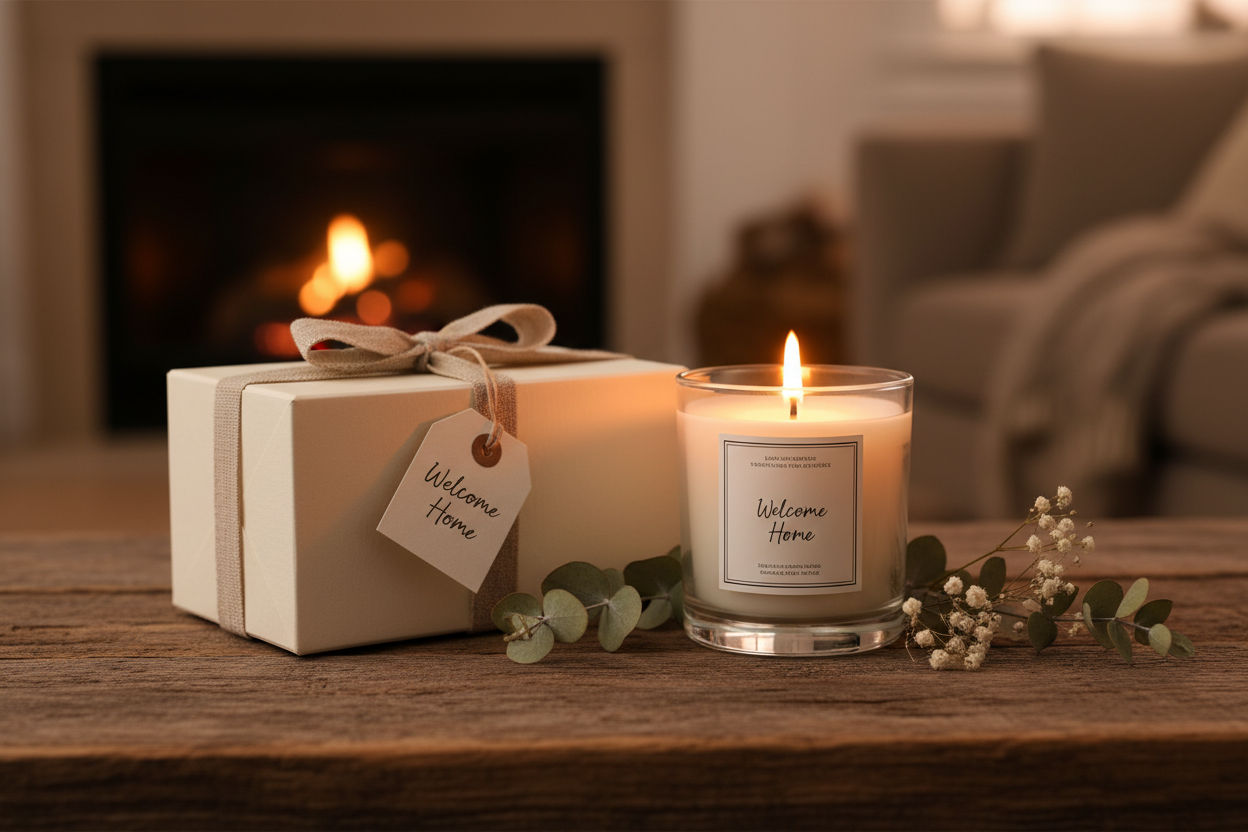
Article
Formulating the Best Housewarming Candle Gift
A Thoughtful Candle Gift That Feels Like Home
A candle brings something quiet and grounding to a new space. It doesn’t compete for attention or take up too much room. It simply works. For new homeowners still finding their rhythm, a well-made candle offers comfort without trying too hard.
It doesn’t need to be sentimental. It just needs to feel settled.
What to Pick When You’re Not Sure What Scents They Like
Go Neutral, Not Boring
Clean cotton, mild citrus, soft florals, and subtle woods tend to land well in unfamiliar spaces. These profiles avoid sharp edges and sit lightly in the air, making them easier to appreciate without guessing personal preferences.
Heavy spice, earthy greens, or complex layered blends can come off as too specific. The goal is to offer something they’ll actually light, again and again.
Set the Mood Without Overpowering the Space
A good housewarming scent blends in without fading. It holds presence but doesn’t announce itself every time someone enters the room. Fragrance oils balanced in a soy wax tend to throw well without overwhelming small spaces.
The best candle gifts create atmosphere, not distraction.
Making Sure Your Candle Gift Doesn’t End Up in a Drawer
Why the Container Can Make or Break a New Home Candle Gift
Scent might draw attention first, but the container decides whether a candle feels like part of the home. Minimal glass tumblers, amber jars, and soft matte tins tend to disappear into any style without feeling generic. The packaging matters just as much, clean labels, thoughtful materials, and a cohesive unboxing experience can turn a simple housewarming candle gift into something that feels intentional. Branded jars with loud graphics or seasonal themes usually find the back of a shelf.
Burn Quality Matters More Than You Think
The experience breaks down fast with tunneling, uneven melts, or poor fragrance throw. A well-tested wick, properly cured wax, and clean burn make all the difference. That’s what turns a one-time gift into something they want more of.
Poor performance gets noticed quickly. A candle that burns right gets remembered longer.
Personal Touches That Make a New House Candle Gift Feel Special
It’s the Little Things That Leave an Impression
No need for oversized bows or gift baskets. A hand-written note, a craft label with a quiet message, or even a match striker on the jar adds meaning without overdoing it. The best details are the ones that feel natural, not decorative.
Whether It’s Handmade or Private Label, Keep It Personal
Some candles carry stories. A scent created for a new homeowner. A label with the date they got their keys. These kinds of personal touches resonate without being obvious. Whether it's a one-off pour or a consistent gift for realtors or staging pros, the right details add weight without adding volume.
Last Thoughts on Gifting a Housewarming Scented Candle That Hits the Mark
Stick with clean scents, balanced containers, and quiet presentation. Stay away from fragrances that try to do too much. Label clearly and test thoroughly.
Candles don’t need to be bold to be meaningful. They just need to burn well, smell right, and feel like they belong.

Article
How to Create Stunning Candle Gift Sets, Boxes & Baskets
A candle gift set becomes far more meaningful when it is handmade. Instead of gifting finished candles, assembling a basket or box filled with supplies allows the recipient to experience the joy of making their own. These DIY sets are creative, customizable, and perfect for a variety of occasions.
Why Candle Gift Sets Are the Ultimate DIY Gift
DIY candle gift sets stand out because they combine creativity with practicality. They provide the tools and materials to craft something functional, while also offering an engaging activity. A well-assembled set feels thoughtful and personalized, making it suitable for birthdays, holidays, or moments of appreciation.
For makers, bundling supplies into gift sets also creates opportunities for seasonal collections and themed packaging. Each basket or box is not only a gift, but also an experience waiting to unfold.
What to Include in a Candle Gift Basket or Box
The heart of any DIY candle gift set is the collection of supplies. Wax, fragrance oils, wicks, and containers should always be included, with clear instructions to ensure ease of use. Soy wax starter kits and beeswax kits make excellent foundations, giving recipients the basics to begin creating.
To enrich the gift, you might include additional fragrance oils so the recipient can experiment with different blends. Colorants or mica powders allow for personalization, while small tools such as thermometers or stir sticks make the process smoother. A sturdy basket or rigid box lined with filler not only protects the items but also adds to the excitement of opening the gift.
Examples of Great Candle Gift Add-Ons
Add-ons can transform a simple supply kit into a fully curated experience. A wick trimmer or pouring pot elevates the set by including tools that will be used repeatedly. A small journal for noting scent experiments encourages creativity and exploration. Decorative filler, tissue, or ribbon inside the packaging adds polish, making the kit feel special and ready to give. Each extra detail contributes to the overall sense of care and inspiration.
Types of Candle Gift Sets You Can Make
DIY candle gift sets can be adapted to match the skill level or occasion of the recipient. A beginner’s box may include a soy wax starter kit with pre-measured supplies and a step-by-step guide. A luxury box might feature frosted jars, high-end fragrance oils, and elegant packaging with metallic accents. Seasonal sets can highlight specific themes, such as cinnamon and pine scents for winter or floral and citrus oils for spring and summer.
Matching Candle Types with Themes
Choosing the right supplies helps tie each gift set to a specific mood or event. Aromatherapy-themed sets might focus on eucalyptus or lavender oils paired with natural soy wax. A holiday-inspired basket could feature cinnamon and vanilla fragrances with red or green colorants. Romantic boxes shine with rose, sandalwood, or amber oils, enhanced by decorative jars and elegant lids. By aligning fragrance oils, containers, and packaging, you create cohesive sets that feel intentional and memorable.
Best Candle Making Kits & Supplies to Use
High-quality supplies make all the difference in a candle gift set. Soy wax kits are ideal for beginners due to their clean burn and consistent results. Beeswax kits appeal to those who prefer a natural material with a subtle, honey-like aroma. A variety of fragrance oils gives recipients freedom to explore different profiles, while wicks in various sizes ensure proper burns.
Containers provide both function and style, with tins offering a rustic charm and glass jars delivering a polished, modern feel. Including labels or blank tags adds flexibility for personalization. For those gifting to first-time makers, a candle starter kit with carefully measured ingredients ensures an enjoyable and successful experience.
How to Package Candle Gift Sets Beautifully
Presentation is essential to the appeal of a candle gift set. Choose packaging that secures the supplies while reflecting the theme of the gift. Wooden crates, sturdy baskets, or magnetic closure boxes work well as bases. Line them with shredded paper or fabric to cushion the items, then arrange the supplies in a way that feels organized and inviting.
Including an instruction card helps guide beginners through the process, while decorative touches like ribbons or sprigs of dried herbs make the set feel more personal. The unboxing should feel just as rewarding as the candle-making process itself.
Labeling & Personalization Tips
Labels and personalization provide finishing touches that elevate the experience. You can create custom labels for fragrance oils or containers inside the kit, or include blank labels so the recipient can decorate and name their finished candles. A handwritten note describing the inspiration behind the set adds a thoughtful element. For makers selling DIY kits, branding through cohesive labels, packaging, and color choices reinforces professionalism and creates a lasting impression.
Where to Sell or Share Your Candle Gift Sets
Candle-making gift sets are versatile, making them appealing in both personal and professional contexts. For hobbyists, they make memorable gifts for family and friends. For small business makers, selling curated supply boxes at craft fairs, online marketplaces, or through social media offers a way to connect with audiences who value creative, hands-on gifts.
Styled product photography and packaging demonstrations help potential buyers understand the value of the set. For those producing in larger quantities, sourcing supplies in bulk ensures consistent quality while keeping costs manageable.
Final Tips for Crafting the Perfect Candle Gift Set
The best DIY candle gift sets balance function, creativity, and presentation. Select reliable supplies that make the process enjoyable, then add opportunities for personalization through fragrance choices, colorants, and container styles. Pay close attention to packaging, as thoughtful presentation makes the gift feel more complete.
Above all, remember that each kit is more than just a basket of supplies, it is an invitation to create, to relax, and to craft something beautiful by hand.
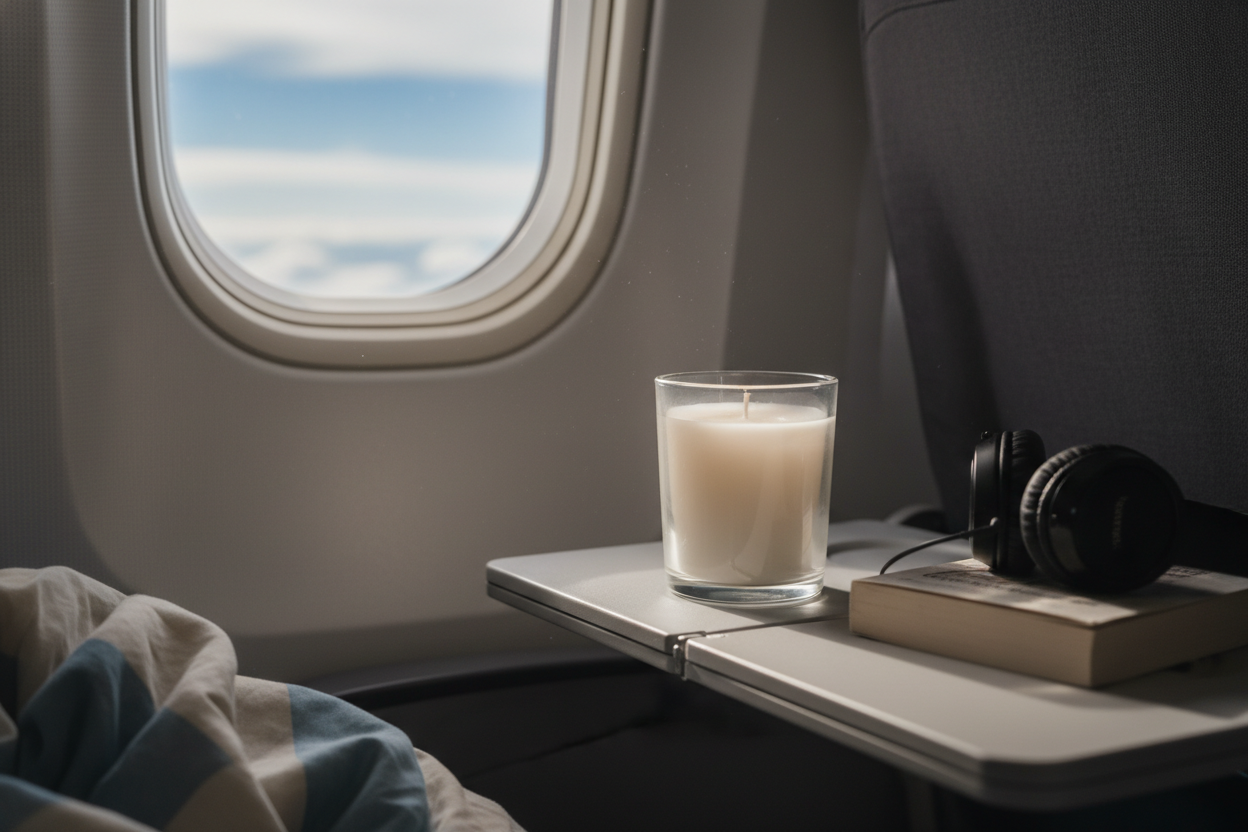
Article
Can You Bring Candles on Planes?
Whether you’re a candle maker traveling to a market, bringing a handmade gift to a friend, or just can’t go without your favorite scent, you may be wondering: Can you bring candles on planes? The short answer is yes, but the details depend on the type of candle and where you pack it.
This guide covers TSA rules, carry-on vs. checked luggage, packing tips, and advice for makers traveling with supplies.
TSA Rules for Bringing Candles on Planes
TSA does allow most candles on planes, but there’s a difference between solid wax candles and gel candles:
Solid candles, like soy, beeswax, or paraffin, are allowed in both carry-on and checked baggage.
Gel candles are considered a liquid/gel by the TSA. These must follow the 3-1-1 liquids rule if in your carry-on (3.4 oz or less, in a quart-sized bag), or go in checked baggage.
Pro Tip: Always check TSA’s official website before flying, as rules can change.
Carry-On vs. Checked Luggage for Candles
Carry-On Benefits:
Better protection from breakage.
Easy access if you want to show them at security.
Checked Bag Benefits:
No size or weight restrictions for candles.
Ideal for bulk quantities or market inventory.
Things to Consider:
Candles can be heavy, factor this into your luggage weight limits.
Fragrance-heavy candles can sometimes raise questions at screening if the scent is strong.
How to Pack Candles for a Flight
The goal is to protect both your candles and your luggage contents. Here’s how:
Wrap individually: Use bubble wrap or foam sleeves around each candle.
Cushion well: Place wrapped candles between clothing or packing peanuts.
Seal against leaks: For soft wax or scented candles, wrap in plastic before cushioning.
Can You Bring Candle-Making Supplies on a Plane?
Many candle makers travel with supplies for workshops, shows, or markets. Here’s what’s generally allowed:
Wax (solid blocks or pellets): Allowed in both carry-on and checked bags.
Fragrance oils & essential oils: Count as liquids and must follow TSA’s 3-1-1 rule in carry-on; no restrictions in checked luggage.
Wicks, molds, labels, tins: No restrictions, but pack carefully to avoid damage.
Maker Tip: If traveling internationally, check customs rules for importing wax, oils, or botanicals.
Common Questions About Traveling With Candles
Can I bring a candle in my carry-on?
Yes, if it’s a solid candle, TSA allows it in carry-on luggage.
Are candles allowed in checked luggage?
Yes, both solid and gel candles are allowed in checked bags. Gel candles are easier to transport in checked baggage to avoid liquid restrictions.
What does the TSA check candles for?
They may inspect candles to ensure there are no prohibited substances or hidden items inside.
Can you bring scented candles on a plane?
Yes, scented candles are allowed. Just be mindful of strong fragrances in enclosed spaces.
Tips for Candle Makers Traveling to Markets or Shows
Ship in advance when possible: For large quantities, shipping candles to your destination may be easier and safer.
Bring small repair supplies: Wick trimmers, extra labels, and small amounts of wax for touch-ups can be lifesavers.
Final Thoughts on Flying With Candles
Yes, you can bring candles on planes, just remember TSA’s guidelines, choose the right luggage option, and pack with care. For candle makers, traveling with products can be smooth with a little preparation.
And if you need durable, travel-friendly candle containers, fragrance oils in TSA-approved sizes, or professional packaging to keep your candles safe, The Flaming Candle has you covered.

Article
Do Candles Have an Environmental Impact?
Candles offer warmth, fragrance, and ambiance, but some makers and customers are asking important questions about sustainability. Do candles cause pollution? Are certain waxes or wicks more eco-conscious than others? Can candles affect indoor air quality?
If you're looking to reduce your environmental impact while still enjoying the craft, choosing responsibly sourced materials, avoiding waste, and following clean-burning guidelines is a good place to start. Try our ECO Candle Wick Series, designed to minimize mushrooming and soot leading to a cleaner, more efficient burn.
If you're trying to make more informed choices for candle air pollution or sustainability, either as a consumer or small-batch maker, understanding the environmental considerations behind candle ingredients and production is a great place to start.
Are Candles Bad for the Environment?
Candles are not inherently harmful, but like many consumer products, their environmental footprint depends on the materials used, how they are made, and how they are burned.
The Carbon Footprint of Candles
All candles release small amounts of carbon dioxide when burned. This is true for paraffin, soy, beeswax, and other fuel-based waxes. However, the emissions are relatively low compared to other common household activities. Still, large-scale production and transportation of raw materials can add to a product’s total carbon footprint.
Do Candles Release CO2?
Yes, burning any hydrocarbon-based wax releases CO₂. Paraffin, which is derived from petroleum, has a higher carbon output per gram burned than soy or coconut wax. That said, burning one or two candles in a ventilated room will not create dangerous CO₂ levels on its own.
Candles and Indoor Air Pollution
Scented candles can contribute to indoor air pollution, especially if they’re made with lower-quality ingredients or burned improperly.
Do Candles Contribute to Indoor Air Pollution?
Incomplete combustion, long wicks, or poor ventilation can cause candles to release soot and volatile organic compounds (VOCs). Over time, this can accumulate in enclosed spaces. Most concern comes from paraffin wax burned in unventilated areas or heavily fragranced candles without proper formulation testing.
Are Candle Fumes or Smoke Toxic?
There’s no strong evidence that occasional use of scented candles in a ventilated space poses health risks. Still, prolonged exposure to soot or strong synthetic fragrances can irritate sensitive individuals. Using candles with high-quality fragrance oils and following IFRA guidelines helps reduce this risk.
Are Candles Sustainable?
Sustainability varies across wax types, production methods, and packaging practices.
Comparing Wax Types: Paraffin vs. Soy vs. Coconut
Paraffin wax is petroleum-derived, non-renewable, and has a higher carbon footprint.
Soy wax is plant-based and renewable but may involve heavy land use or deforestation depending on the source.
Coconut wax tends to require less land and water to produce and is often praised for its lower environmental impact.
When evaluating sustainability, it helps to look at the full supply chain, including how crops are farmed and whether waxes are blended or pure.
Packaging, Sourcing, and Waste Considerations
Glass containers, such as Jelly Jars, can be reused or recycled, but not all candle vessels are recyclable through curbside programs. Avoiding plastic-heavy packaging, sourcing locally when possible, and batching orders for shipping can help reduce waste in production and delivery.
Tips for Choosing More Eco-Conscious Candle Supplies
Cleaner Wicks and Fragrance Guidelines
Look for wicks that are lead-free and made from cotton or paper cores. Use fragrance oils at recommended levels based on IFRA’s usage standards. Overloading candles with fragrance can lead to poor burn performance and increase indoor emissions.
Reducing Waste in Candle Making
Test in small batches to avoid excess waste
Repurpose glass containers when safe and appropriate
Print labels in bulk to cut packaging material use
Use recyclable filler and craft boxes for shipping
Frequently Asked Questions
Q: Are candles pollutants?A: Candles do emit small amounts of CO₂ and soot, but when burned properly and made with quality materials, their environmental impact is considered minimal in the home.
Q: Do candles cause air pollution?A: Improper burning or poor ventilation can lead to soot or VOCs building up indoors. Trimming the wick and burning candles in a ventilated space reduces this risk.
Q: Do candles pollute indoor air?A: Yes, if burned improperly or made with low-quality wax and fragrance. Choose clean-burning ingredients and follow best practices for wick trimming and ventilation.
Q: Are candles bad for the environment?A: Some waxes, like paraffin, are said to have a larger environmental footprint. More sustainable alternatives include soy or coconut wax, especially when sourced responsibly.
Q: Do candles release CO₂?A: Yes, all candles release carbon dioxide as part of the combustion process. Plant-based waxes tend to have a lower carbon footprint than petroleum-derived waxes.
Q: Do scented candles pollute the air?A: They can, depending on the quality and amount of fragrance used. Following IFRA usage limits and choosing safe, tested fragrances helps prevent overloading the air.
Q: Are candle fumes toxic?A: Most fumes are not considered toxic at normal usage levels, but people with sensitivities may react to strong scents or excessive soot. Choosing clean, well-formulated products helps prevent this.
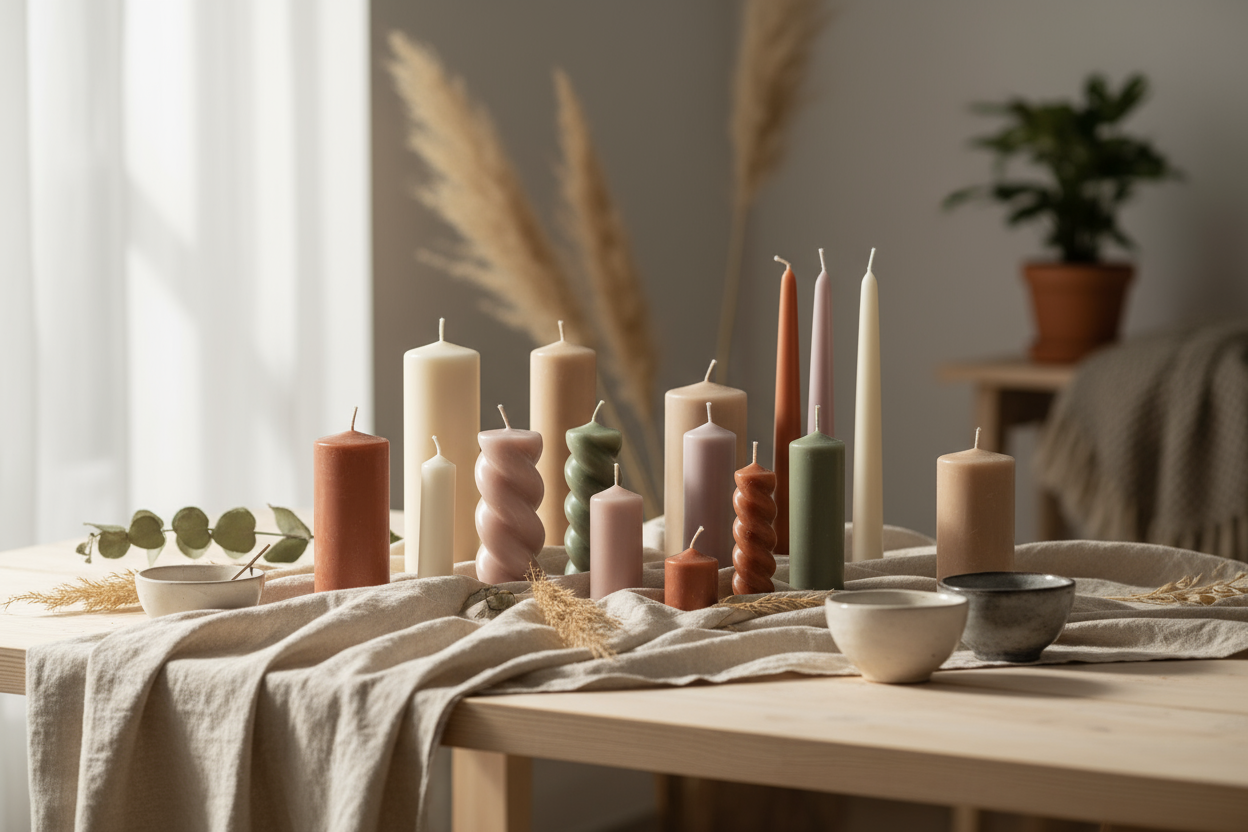
Article
Why Is My Candle Color Fading or Changing?
You spent time perfecting the shade of your candle, only to check back later and notice the color has shifted or faded almost completely, without intending to make a color changing candle! Whether your candles are meant for personal use or retail, color changes can affect the overall look and feel of your product. So why does this candle wax discoloration happen?
Candle color fading or discoloration is typically the result of environmental exposure, ingredient interaction, or the natural aging of materials. Here’s how to understand it, prevent it, and know when it signals something more.
For long-lasting color and performance, start with high-quality materials and proper storage practices. Explore our full Candle Dyes Collection and try a tested shade like Red Liquid Candle Dye for reliable color control from batch to batch.
Why Does Candle Wax Change Color Over Time?
Candle color doesn’t just fade without a cause. Most of the time, changes are linked to how the candle was formulated and stored. Both natural and synthetic dyes can shift in appearance under certain conditions.
UV Light, Fragrance, and Additive Reactions
Ultraviolet (UV) exposure is one of the most common causes of fading. When candles sit in direct sunlight or strong artificial lighting, dyes can break down or become unstable. Even if the wax looks fine at first, you may notice fading or yellowing after a few days or weeks.
Some fragrance oils, especially those with vanilla or citrus compounds, can also interact with certain dyes and cause discoloration or patchiness. The presence of UV inhibitors, stabilizers, or certain wax additives may help in some cases, but results vary depending on the wax type and formulation.
Color Shifts in Natural vs. Dyed Candles
Natural waxes like soy or beeswax often have a slight tint of their own. This can affect how the final candle color looks, especially with lighter shades. Over time, that natural wax tone may deepen, which makes pastels or delicate hues appear uneven or washed out.
Pigment-based dyes tend to hold up longer than liquid dyes but may still be affected by fragrance or oxidation.
How to Make Candles Last Longer
Even if your candles are beautifully colored today, poor storage can reduce how long that color holds. Here are some notes for improving candle care.
Storage Tips for Finished Candles
Store candles in a cool, dark area away from direct sunlight
Avoid placing finished candles near heat vents, windows, or warm storage rooms
Use airtight or UV-protective packaging for long-term shelf life
Keep candles away from high-humidity environments that may accelerate degradation
If you're producing in bulk, clear labeling and rotation schedules can also help keep your inventory looking its best.
Does Candle Wax Expire or Go Bad?
Candle wax does not expire in the same way food does, but it can degrade over time, especially when exposed to oxygen, UV light, or high temperatures. This affects not only fragrance throw and burn quality but also the appearance of the wax.
Signs of Aging in Wax and Colorants
Fading or yellowing of originally vibrant colors
Uneven coloration or mottling in dyed candles
A sour or off smell in the wax itself
Brittleness, cracking, or frosting, especially in soy wax
These signs do not always mean the candle is unsafe to burn, but they may suggest that the materials are past their best quality.
Frequently Asked Questions
Q: How do I color candles without fading?A: Use high-quality dyes that are compatible with your wax type. Avoid overexposure to light and heat during curing and storage.
Q: What’s the best way to dye candle wax?A: Liquid dyes work well for consistent color, while dye blocks offer more control in smaller batches. Always test your exact wax and fragrance combination to monitor for color stability.
Q: Do candles go bad over time?A: Not in the traditional sense, but both wax and colorants can lose performance if stored improperly. Keep materials in a cool, dry, and dark space to extend shelf life.
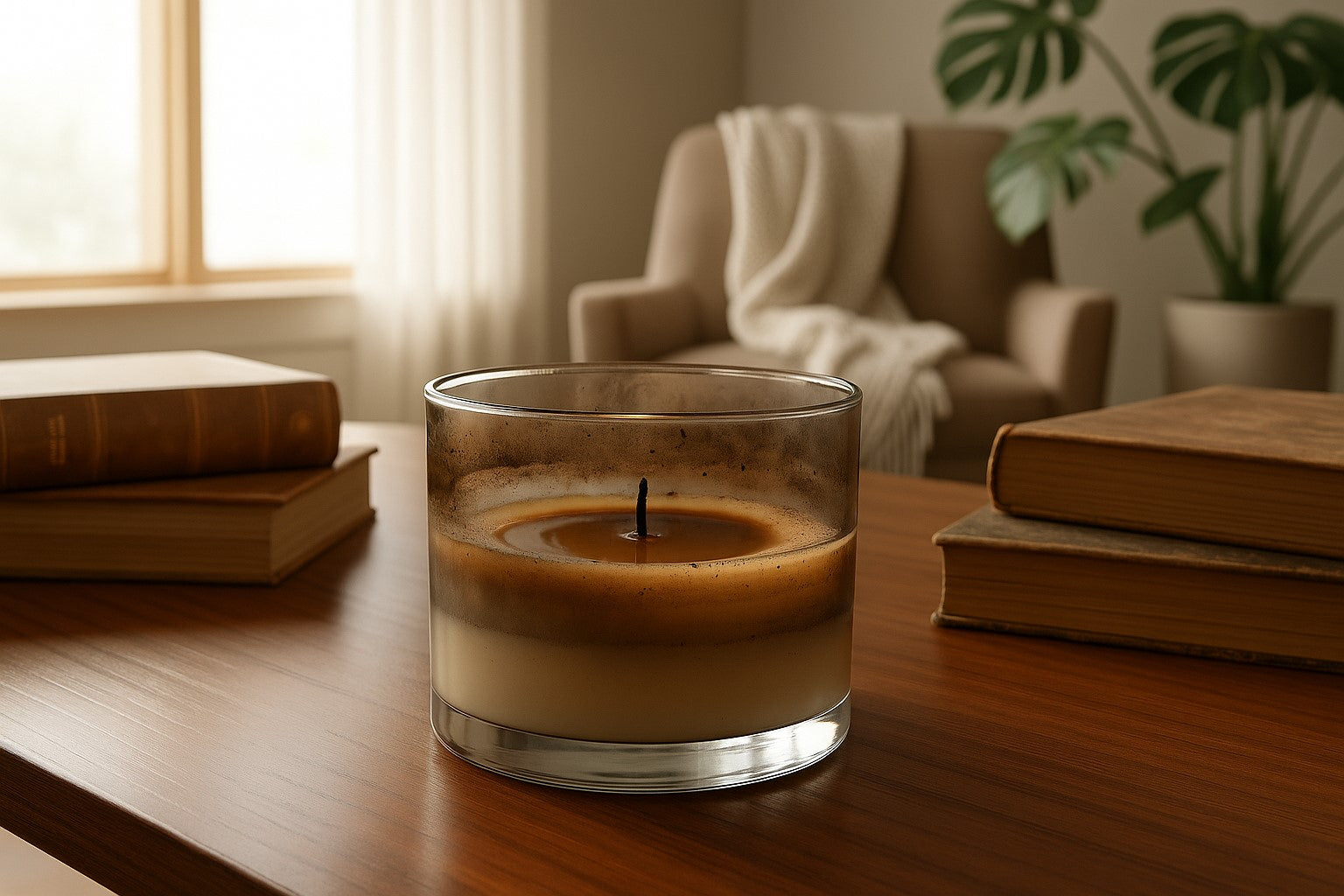
Article
How to Remove & Prevent Soot in Candles
Candle soot happens when your candle doesn’t burn as cleanly as it should. It’s the black residue you might notice on glass jars, nearby walls, or even ceiling corners after repeated burning. While some soot is normal over time, it shouldn’t be excessive or constant.
Want to create cleaner-burning candles from the start? Explore our full Candle Wicks Collection and check out our “What Candle Wick Size Do I Need?” Guide to improve burn performance from the very first test.
If your candles are turning surfaces black or leaving a smoky smell behind, there are a few burn habits and formulation adjustments you can make to fix it. Wonder why do candles produce soot? Here’s the know and how to stop candle soot.
What Causes Candle Soot?
Soot forms when the wax fuel is not fully burned during combustion. This can happen for a few reasons, most of them related to how the candle is built or how it’s being used.
Poor Combustion and Airflow Issues
When a candle flame doesn’t get enough oxygen or burns too hot, it releases tiny black carbon particles. These are what you see as soot. Poor airflow in a room, drafty locations, or even improper trimming can lead to an unstable flame that produces more soot than necessary.
Consistently high flames are a red flag. These flames tend to pull up more wax than the flame can consume cleanly, which leads to incomplete combustion and residue buildup.
Effects of Wick Type and Fragrance Load
Wicks that are too large, too long, or poorly matched to the wax can increase the likelihood of soot. A high-fragrance candle, especially one with a heavy oil load or ingredients like vanillin, can also contribute. Always ensure your fragrance usage follows IFRA safety standards.
How to Prevent Candle Soot
The best way to deal with soot is to reduce the conditions that cause it. A few small steps during production and use can make a big difference in burn quality.
Clean Burning Candle Techniques
Trim the wick to ¼ inch before each burn
Burn your candle long enough to allow a full melt pool, but no more than 4 hours at a time
Avoid burning candles near windows, fans, or HVAC vents
Candles with stable flames and full melt pools typically burn cleaner and leave less residue behind.
Ideal Wick Sizing and Container Choices
Always test your wick size with the specific wax and fragrance oil you are using. If the wick is too large, it will burn hotter than necessary and produce more soot. The same goes for the container. Glass designed for candles should tolerate heat evenly and be the right shape for the melt pool to develop properly.
If you're working with jars around 2.5 to 3 inches wide using soy or soy-paraffin blends, the CD 10 Wick – 6" Pre-Tabbed (100 count) offers clean and steady burn performance with reduced soot.
You can also explore more size options in our full Candle Wicks Collection to match your specific vessel and wax type.
Cleaning Candle Soot Residue
If your walls or candle jars already show soot, here’s how to clean them without damaging paint or surfaces.
How to Remove Black Marks from Walls
Use a soft cloth with mild soap and water or a diluted vinegar solution to gently wipe soot-stained walls. Avoid harsh scrubbers, which can smear the residue or strip paint. For heavier buildup, a dry chemical sponge or “soot sponge” may be helpful.
If you’re dealing with soot on glass containers, rubbing alcohol or a gentle all-purpose cleaner usually removes residue easily.
Tips for Long-Term Burn Safety
Keep a 1-foot clearance around burning candles
Never leave a candle burning unattended
Use containers made for candle use, and avoid repurposing jars not rated for heat
Frequently Asked Questions
Q: How do I get candle soot off my walls?A: Use a damp cloth with mild dish soap or vinegar. Gently wipe the affected area and avoid over-saturating the wall.
Q: Is black soot from candles dangerous?A: While occasional soot is not usually harmful in small amounts, excess indoor soot over time can affect air quality. Clean-burning habits reduce exposure.
Q: Why do my candles turn black?A: Blackened glass or smoke trails are usually caused by an oversized wick, burning for too long, or poor airflow. Trim the wick and limit burn sessions to 3 to 4 hours.
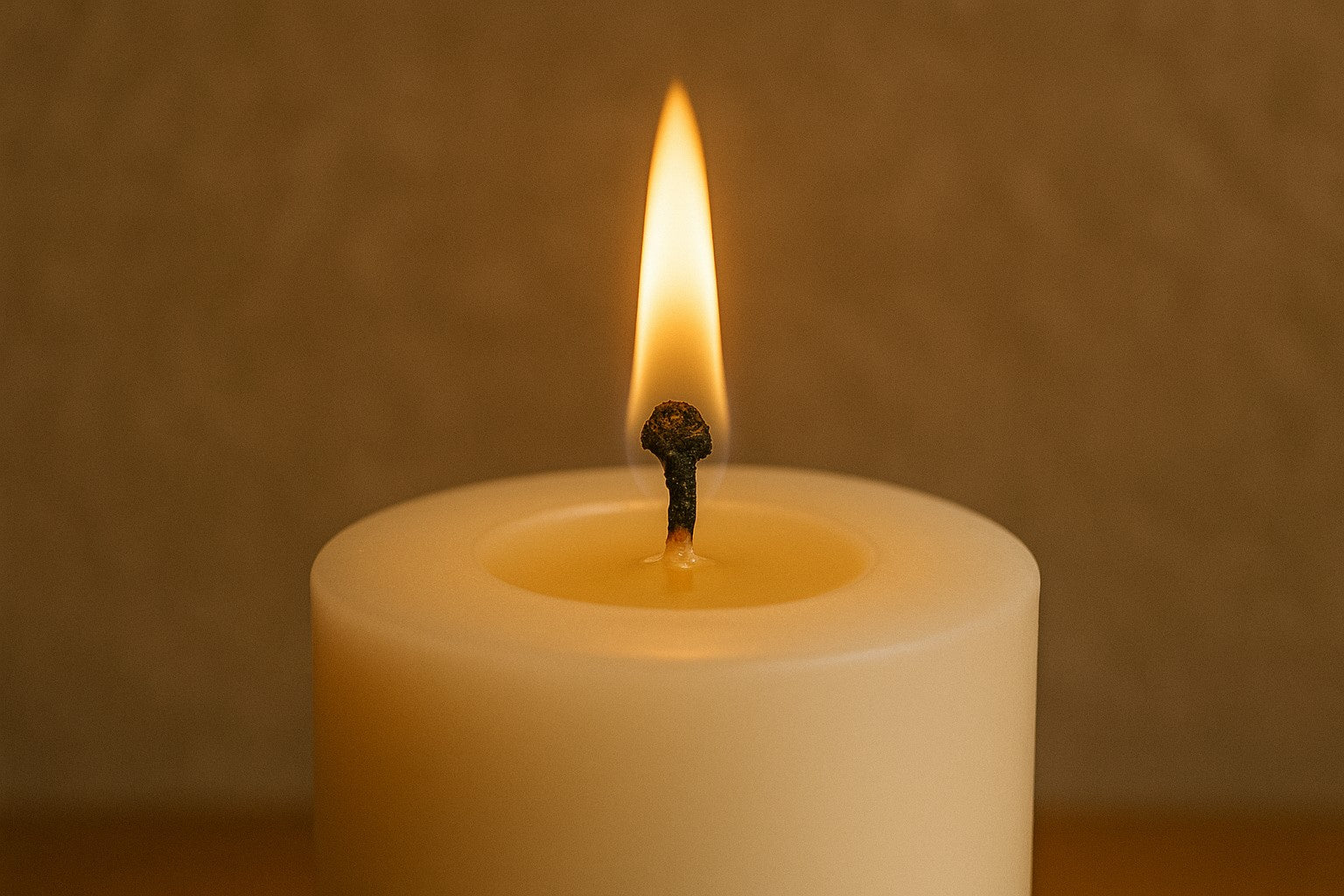
Article
Why Do Candle Wicks Mushroom and How To Prevent It?
If you've ever noticed a ball of carbon forming at the tip of your wick, like a tiny mushroom cap, that's called wick mushrooming. It's a common issue in both handmade and commercial candles, but with the right adjustments, it can be managed or prevented.
What Is Wick Mushrooming?
Wick mushrooming refers to carbon buildup at the tip of the wick during burning. It usually appears as a round or lopsided bulb and may cause the flame to flicker, lean, or burn too hot. You might also see extra smoke or soot forming on the jar or around the wick.
Why Do Candle Wicks Curl or Form a Bulb?
The curled shape is often part of the wick’s design to help it self-trim. But when too much wax is pulled into the flame, especially if the wick is oversized or the burn environment isn’t ideal, more fuel is delivered than the flame can fully combust. What’s left behind is that telltale mushroom-shaped tip.
What Causes Candle Wicks to Mushroom?
A few key factors make this issue more likely, especially in highly scented or long-burning candles.
Overwicking and Fragrance Load Impact
One of the most common causes of mushrooming is using a wick that is too large for the wax, container, or fragrance load. When a large wick draws up excess wax and fragrance oil, the flame burns too hot and can’t use all the fuel efficiently. The unburned carbon collects at the wick’s tip and forms the mushroom.
Heavy fragrance loads, especially those with complex blends or vanillin, can also influence burn behavior. Be sure to test your formulation carefully and consult IFRA usage rates to ensure you are within safe, stable ranges.
How to Prevent Wick Mushrooming
While it is not always possible to eliminate mushrooming entirely, a few burn and production habits can reduce how often it happens.
Proper Wick Trimming Habits
The easiest fix is trimming your wick before every burn. A wick trimmed to ¼ inch reduces the amount of fuel feeding the flame, leading to a cleaner burn and better flame control. Never let mushroomed wicks continue burning. They can produce soot, create unstable flames, and increase the risk of container overheating.
Choosing the Right Wick Size for Your Wax
Mushrooming often signals that the wick is too thick or the wrong type for your formula. Softer waxes like soy usually require thinner wicks, while paraffin blends can support a wider range.
When testing your candle design, start with a wick recommended for your container diameter and wax type, then adjust based on burn performance. If you are unsure where to begin, TFC’s CD Wick Series is a dependable choice for smooth-burning soy and soy-paraffin blends. If you're working with a container around 3.5 to 4 inches wide and using a soy or soy-paraffin blend, the CD 18 Wick Pre-Tabbed (100 count) offers steady flame control and helps reduce carbon buildup when trimmed to ¼ inch.
Frequently Asked Questions
Q: How do I trim a candle wick properly?A: Use scissors or wick trimmers to cut the wick to about ¼ inch before each burn. Remove any carbon buildup or mushrooming before relighting.
Q: Why does my candle wick curl at the top?A: Some wicks are designed to curl slightly as they burn. This helps them self-trim, but excessive curling with mushrooming usually means the wick is too large or the wax is over-fueled.
Q: Can I stop candle wicks from mushrooming completely?A: You can reduce how often it happens by choosing the right wick, managing fragrance load, and trimming before each burn. Minor mushrooming is sometimes normal, especially in richly scented candles, but should never be ignored.
Q: Is mushrooming dangerous?A: If left untrimmed, a mushroomed wick can create a large flame, produce soot, and overheat the jar. Always trim between burns for safety.
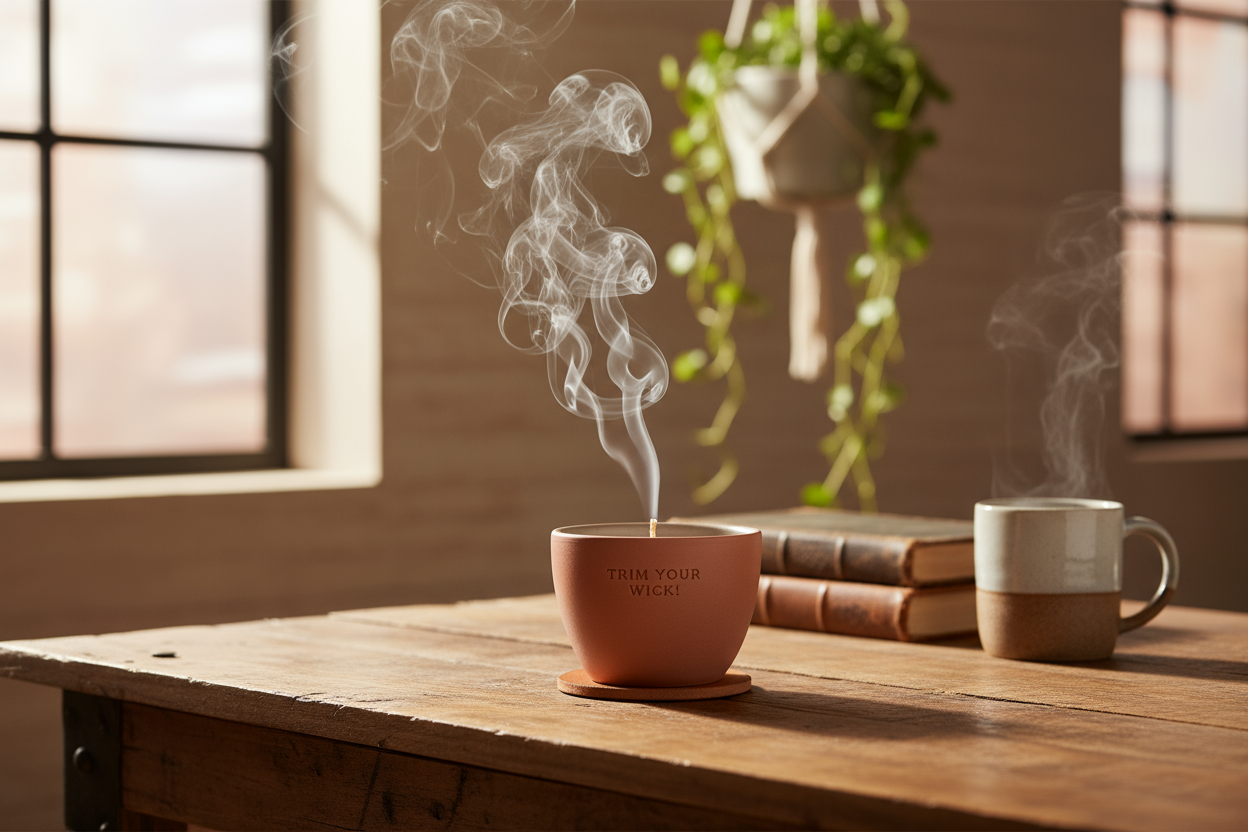
Article
Why Is My Candle Smoking & How To Stop It
A lit candle should burn cleanly, with a steady flame and little to no smoke. So if yours is throwing off black wisps or popping like a campfire, something’s off. Whether you’re troubleshooting a wooden wick candle or just wondering why is my candle smoking so much, the fix usually comes down to a few simple adjustments.
Why Is My Candle Smoking?
Excess smoke from a candle, especially black smoke, usually means the flame is burning too large or too hot. That can happen for several reasons:
The wick is too long
The wick is too thick for the wax and vessel
There’s debris (like soot or char) feeding the flame
Airflow is causing an unstable burn
The wax or fragrance load isn’t burning cleanly
Let’s break down the most common causes and how to stop candle smoke for good.
1. Wick Too Long or Not Trimmed
This is the #1 cause of candle smoking. If the wick gets too long, it starts to mushroom, which leads to a bigger, smokier flame.
Fix it: Trim your wick to ¼ inch before every burn. For wooden wicks, 1/8 inch works best.
If you're seeing black soot around the jar rim, chances are the wick needs a trim.
2. Wick Too Large for the Candle
A wick that’s too wide or thick can draw more wax than the flame can cleanly burn. That results in a larger flame, more smoke, and sometimes a torch-like effect.
What to look for:
Big flame
Fast melt pool
Smoke or soot shortly after lighting
If this sounds like your setup, consider sizing down your wick or switching to a different series better suited for the wax and container diameter.
3. Drafty or Unstable Burning Conditions
If the flame is flickering or dancing too much, airflow might be feeding extra oxygen to the flame, making it unstable and smoky.
Avoid burning candles near:
Open windows
Fans
AC vents
A stable burn = a clean burn.
4. Debris in the Wax Pool
Leftover wick trimmings, charred material, or dust can interfere with how the wax burns. These can act like extra fuel, making the candle smoke or pop. Check the melt pool before each burn, and keep it clean.
5. Too Much Fragrance or Additives
An overloaded candle, whether with fragrance oil, dye, or other additives, can struggle to burn cleanly. Overloaded wax may not fully combust, and that excess can come out as smoke.Stick to your wax’s maximum fragrance load (as defined by the manufacturer) and use quality-tested candle fragrances. If you’re experimenting with dye or custom blends, test burns are essential.
Why Is My Candle Smoking Black?
Black smoke is usually unburned carbon from a too-large flame. The solution is almost always to:
Trim the wick
Reduce drafts
Check wick sizing
If the black smoke is coming from a wooden wick, trimming even a sliver off the top can make a big difference. Don’t relight a wooden wick without trimming off the charred end.
Why Is My Wooden Wick Candle Smoking?
Wooden wicks can sometimes be more prone to smoking if:
They’re not trimmed close enough to the wax surface
The wick size isn’t properly matched to the container
The wood has absorbed fragrance or moisture
Use clean, dry wooden wicks made for candle making, never repurpose craft wood or popsicle sticks.
How to Stop a Candle From Smoking
Here’s your quick checklist to stop candle smoke:
Trim the wick before each burn
Use the right wick size and style for your wax and container
Burn in a draft-free area
Keep the wax pool clean
Stick to tested fragrance loads
Popping, Crackling & Bubbly Noises
A little soft crackle from wooden wicks is normal, but loud popping or bubbling sounds can indicate:
Moisture in the wick
Trapped air from improper wax pouring
Debris or additives affecting the burn
Always store wicks in a dry area, and pour wax slowly to avoid air pockets. If the candle sounds like it’s boiling, blow it out and inspect the melt pool.
Final Burn Tips
Clean-burning candles start with the right wick, wax, and testing. Smoke is a sign that something’s out of balance, but the fix is usually easy. For makers, it’s a reminder to revisit wick selection, wax compatibility, and fragrance percentages. For candle lovers, it might just be time for a trim.
If your candle is producing more smoke than scent, your flame is trying to tell you something.
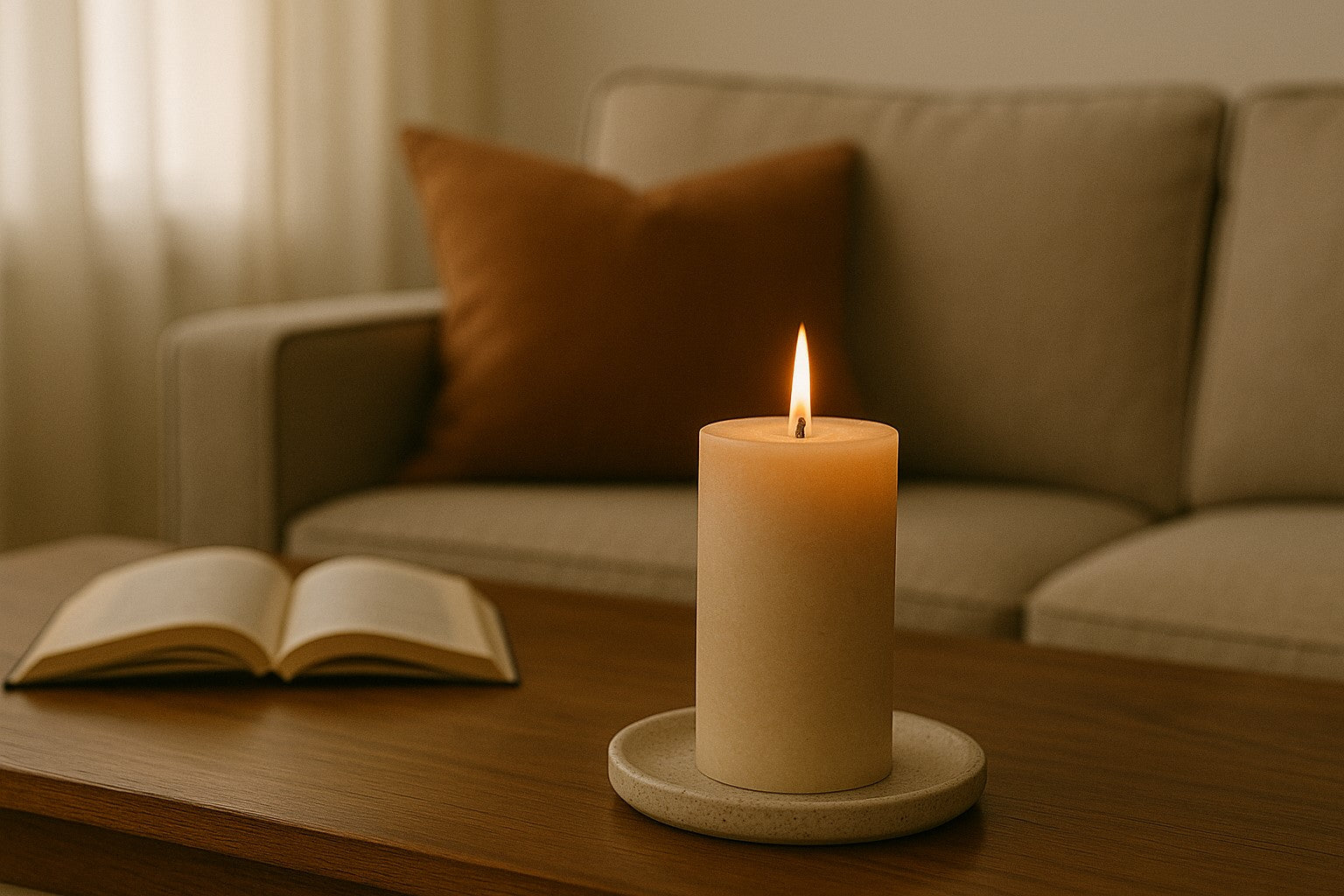
Article
Why Is My Candle Flame Too High or Too Small?
A healthy candle flame should burn evenly: steady, centered, and within a safe height range. If your flame looks unusually tall or barely visible, it’s often a sign of issues with wick sizing, wax behavior, or burning conditions.
Let’s take a closer look at what causes these flame problems and how to address them safely and effectively.
What Does a Flickering or Unstable Candle Flame Mean?
An unstable or flickering flame usually points to airflow disruptions or fuel inconsistencies. If your candle is near a window, HVAC vent, or fan, the flame may appear to dance or shift irregularly. It can also happen if the wick is too long or if the wax isn't melting evenly across the surface.
Pro Tip: If your flame flickers constantly in a still environment, trim the wick with wick trimmers and evaluate your wick size and wax compatibility.
Why Is My Candle Flame So High?
A tall, “jumping” flame often means the candle is burning too hot, which affects both performance and safety.
Overwicking and Drafty Spaces
The most common cause of a high flame is a candle wick that’s too large or too long. A longer wick draws more wax into the flame than needed, resulting in excess heat. This can:
Overheat the container
Lead to soot buildup
Increase fire risk if the flame exceeds safe height
For most container candles, flame height should stay between ½ and 1 inch. Larger pillars or tapers may have flames up to 2 inches. The ASTM standard limits indoor candle flames to a maximum of 3 inches in height.
Fix it: Trim the wick to ¼ inch before each burn. If your flame is still too high after trimming, the wick may be too thick for the wax type or vessel size.
Why Is My Candle Flame Too Small?
On the other end of the spectrum, a small or shrinking flame may not generate enough heat to melt the wax fully. This prevents a full melt pool and may lead to tunneling.
Wick Drowning and Wax Pooling Issues
When the wax pool floods the wick, the flame can’t stay upright or draw in enough fuel. This often happens when:
The wick is trimmed too short
The wax pool builds up from tunneling
The wick sits below the surface of melted wax
Fix it: Carefully remove some melted wax with a spoon or paper towel while the wax is warm. Let the surface level out, then relight with a properly trimmed wick. If this keeps happening, you may need a larger or different wick series. Also consider wick stickers to stabilize the base of the wick.
Understanding Candle Flame Behavior
Candle flame movement tells you a lot about how the candle is performing. Here’s how to interpret different flame shapes and motion.
What Does a Dancing Flame Indicate?
A moving or swaying flame often means there’s airflow around the candle. If the environment is draft-free and the flame still moves, it may be overwicked or influenced by additives in the wax or fragrance oil.
Always check that your fragrance oil usage rates follow current IFRA guidelines and that your wick is properly matched to your formulation.
Can Flame Shape Signal a Burn Issue?
Yes. Here are some common flame shapes and what they may suggest:
Cone-shaped, steady flame: Normal and efficient burn
Tall, narrow flame: Wick too long or too thick
Short, dim flame: Wick too short or underwicked
Sputtering or smoky flame: Excess fragrance or contamination
What Does a Dancing Candle Flame Mean Spiritually?
While some people interpret dancing flames as signs of energy or presence, we focus on performance. If your flame is moving unpredictably, trim the wick and check for drafts or wick sizing issues before assigning symbolic meaning.
Frequently Asked Questions
Q: Why is my candle flickering even when there's no draft?A: The wick may be too long, or the wax may not be melting evenly. Trim to ¼ inch and ensure the melt pool reaches the edges.
Q: How do I fix a small flame that won’t stay lit?A: Your wick could be drowning. Carefully remove some melted wax and relight. If the issue persists, switch to a larger wick size.
Q: Why is my candle producing soot?A: A tall flame caused by an overlong or oversized wick can lead to incomplete combustion. Trim regularly and make sure the wick suits your wax blend.
Q: Is it safe to let a candle with a high flame keep burning?A: No. Extinguish the flame, trim the wick, and relight once cooled. High flames can overheat containers and increase the risk of accidents.

Article
How to Make a Room/Linen Spray
A homemade air freshener is one of the best ways to transform your space with a fresh, clean scent. Consider this guide your walk-through on how to make a natural room spray that’s perfect for refreshing linens, spritzing in the air, or just giving your home a pleasing and signature scent.
Why Make Your Own?
Crafting a homemade air freshener means you control the ingredients—no mystery chemicals, just essential oil room spray goodness. This DIY home fragrance uses safe, simple ingredients that come together in minutes. Plus, it doubles as a homemade odor eliminator, making your house smell good without any fuss.
Ingredients You’ll Need
Distilled water: Helps keep your spray clear and free from impurities.
Witch hazel or rubbing alcohol: This acts as a dispersant, helping the oils blend better with the water.
Essential oils: Your favorite essential oil or a calming scent blend.
Glass spray bottle: A reusable, eco-friendly choice that helps preserve the integrity of your oil room spray.
How to Make Room Spray
Fill your bottle halfway with distilled water.
Add 1–2 tablespoons of witch hazel or rubbing alcohol.
Drop in 20–30 drops of essential oils. Choose a scent that lifts your mood or creates the perfect ambiance—lavender for a calming linen spray, citrus for a bright homemade air freshener, or eucalyptus for a natural room spray that feels refreshing.
Shake well before each use.
That’s it! You now have a DIY room freshener that’s perfect for spritzing around the house or on linens. Check out our high-quality oils to find the perfect one for you.
What Base Do You Use for Room Spray?
Most DIY room sprays use a combination of distilled water and a carrier like witch hazel or rubbing alcohol. This base helps disperse the essential oils and ensures the spray evaporates quickly, leaving behind only the lovely scent.
Linen Spray Recipe Ideas
A simple linen spray recipe can use the same formula: distilled water, witch hazel, and essential oils. Try a blend of lavender and chamomile for bedtime linens or citrus and mint for towels.
Tips for Best Results
Use a glass spray bottle to protect the essential oils from degrading in sunlight.
Shake your spray well before each use to re-blend the ingredients.
Store in a cool, dark place to keep your homemade room spray fresh.
Final Thoughts
Making your own room and linen mist is a fun and easy way to elevate your home’s atmosphere. This DIY air freshener lets you experiment with different oils until you find the perfect homemade room spray that makes your house smell good every time you walk in.
Legal Disclaimer: Always use essential oils safely and within recommended dilution rates. Follow IFRA standards when making scented products. Test any product on a small area before spraying widely, and discontinue use if irritation occurs.